People who click through to read this will probably expect a story about rain and mud, since the weather at the NFEC 50 was THE story, but here it’s the backdrop. What follows comes closer to one of those drawn-out race reports that in the dawn of this sport would be handwritten in a journal, in pages and pages of unedited loopy writing, and in more recent history would be composed as an email and sent to a select group of friends with a disclaimer saying, “Please don’t feel like you have to read this,” and at present time is frequently thrown up as a blog post and shared unselfconsciously, excessively detailing the runner’s training, mindset, gear, self-analysis, digestive health and so on and so forth while taking forever to get to any reporting of what actually happened at the race. You’ve been warned.
The Start
At the North Face Endurance Challenge 50-mile Championship last Saturday, December 1, I lined up with many of the absolute best male and female ultrarunners from around the country and world, who were drawn to the Marin Headlands by the event’s status and prize money. The women’s field, as profiled in this article on iRunFar.com, included at least 15 stars of mountain and trail running whom I knew would finish one- to two-plus hours ahead of me, and many more who’d finish a good half-hour or so ahead. It would take strong running to crack the top 20 in the females, as I barely managed to do last year. The guys’ names would be 50 to 100 deep before my name appeared in the results.
In what seems either cocky or Pollyannaish in hindsight and funny to me either way, I requested and got a spot in the first wave of elite starters. (Two more waves followed, each three minutes apart.) A friend suggested I request one, and I thought, “Why not?” The race organizers looked at my past results and said, “Good enough.” I welcomed the opportunity to start with the speedsters to help me run fast and reduce the time I’d have to wait around at the start line. I felt truly excited and inspired by the prospect of standing shoulder to shoulder with these athletes, as if their prowess and youth would literally rub off a little on me. However, when the moment came to cluster in a dark, rainy meadow for the countdown at 5 a.m., I started to feel like a poser, like one of those seat-fillers at the Oscars who sits down when a real star has to go to the bathroom so that it always looks to the TV audience like a full house.
The point is that being in the company of these genuinely elite runners meant I had to remind myself of the reasons I race other than placing high in the field, since the competition was so out of my league—and that’s a good thing. It felt liberating not to worry about how I’d do against so-and-so. In lower-profile local races where I’m like a medium-sized fish in a small pond, I get hung up on racing to place or win, which can enhance the excitement of the experience and motivate me to run better, but also overshadows an otherwise good run if I measure my success primarily against others and get beat.
It also meant I needed a sense of humor and patience as the elites shot ahead after the start and I quickly found myself at the back of the first wave, suppressing the urge to shout, “Hey, you guys, wait for me!”
Over the past weeks as I prepared for this event, I became more eager and optimistic about having a great day on the trails while letting go of concern about how I would fare in the results lineup. All I wanted, I concluded, was to have a better personal experience than last year. As detailed in this report from December 2011, I struggled mentally and physically on the course when I ran it the first time and finished in 9:50—a lackluster time, considering my other 50-milers were well under 9 hours, although the North Face course is slightly longer at 51 miles. If I could stay positive, focused and steady, then I felt confident I’d run faster than last year, enjoy the day more and ultimately “redeem myself” in my mind.
This year, I felt stronger and wiser from having run the Miwok 100K in May (which covers many of the same trails) and the Grand to Grand 167-mile, self-supported stage race. I visualized the parts of the North Face course that gave me trouble last year—in particular, the out-and-back on single track to the north point of the course, and the steep technical descent to Stinson Beach—and felt stoked to tackle them. I recognized my training was less than ideal in the past two months, since I haven’t done any runs longer than about 3.5 hours, and my lower back has been out of whack. But my legs felt zippy, having run two fast, short races in November (a half marathon on the trail and a local 5K).
I settled on a goal range at the North Face 50-mile of breaking 9:30 if the conditions were good, and 9:45 if the weather turned bad or if I had significant problems on the trail, such as a fall or stomach issues. In my dreams I hoped to hit 9 hours, if everything went right.
Then, as anyone who followed the race last week knows, the event changed dramatically at the eleventh hour due to the severe weather forecast. Permitting and safety concerns forced the race organizers to eliminate the entire northern half of the course—the most interesting portion from a runner’s standpoint, in my view—and create a new course of multiple loops on the southern half, which consists mostly of fire roads. The distance would be more than four miles shorter, too—46.8 miles instead of 51.2.
When I got the news on Thursday night, I was so disappointed!
Objectively, I recognized the reroute was necessary and we were lucky the organizers didn’t cancel the race altogether (as they ended up canceling the half marathon and 10K races on Sunday due to extreme weather and degrading trail conditions). Bellyaching about the change fell into the “that’s a nice problem to have” category. I also told myself to embrace the reroute as a different kind of challenge—a mental test of running repeat loops in inclement weather.
But I couldn’t deny feeling deflated that my race plan, which had focused so much on the northern part of the course and the goal to beat my time from last year, was now irrelevant. And the new course seemed pretty darn boring, since I’ve run those loops of fire roads many times over the past seven or eight years at Marin Headlands marathons and 50Ks.
The point of this preface is to show why I wasn’t in the best frame of mind when the race started Saturday morning. Instead of eager, I felt ambivalent. Instead of the fired-up, go-get-’em feeling that can make a race so great, I felt a grim, “Let’s do this thing and get it done.”
Surprisingly, the gusting wind and rainfall didn’t bother me too much. As long as the temperature didn’t approach freezing, and the rain didn’t turn to hail or lightening, it didn’t seem like that big of a deal. Also, I don’t mind running in wet socks and shoes, since it seems to make my feet feel better as the hours wear on and reduces blistering. I liked the dicey weather insofar as it added an element of intrigue to the familiar route.
The Run
The new course could be described as Little Loop – Figure 8 – Little Loop – Figure 8. The first little loop, almost 6 miles, climbs about 1000 feet to a ridge, then steadily descends to a point near the start. From there, the Figure 8 begins by heading north to Tennessee Valley and following the Pirates Cove trail along the coastal cliffs to Muir Beach. Runners return to Tennessee Valley via the steep fire roads on Coyote Ridge. Then, from Tennessee Valley we return on the steady climb up Marincello Road, rejoining the fire road (Rodeo Valley Trail) that’s the backside of the Little Loop. Halfway through, at mile 23 (following the first Figure 8), we also had to run a short spur back to the finish line festival at Fort Barry before heading out for Round 2, because an aid station with a drop bag point was set up at the start/finish area. It would take a great deal of perseverance to turn around and go back out on the course at the halfway point, having momentarily returned to the finish.
The elite wave took off, and I settled into a manageable warm-up pace. I found myself running solo for a short while until the fast guys from the second wave caught up. Just like last year, I marveled at the string of headlight lamps illuminating the hillside trail like a strand of holiday lights. So far, so good—sort of.
The first problem was a goof in my gear choice: I brought my cheaper headlamp instead of my higher-quality one, because I knew I’d dump the headlamp at an aid station with a good chance of never seeing it again, and I didn’t want to lose my better one. Consequently, I had a weak beam combined with weak eyesight. (I recently got glasses to drive at night and am starting to notice I might need reading glasses too.) My depth perception seemed all trippy, and the illuminated raindrops in the headlamp beam created a visual distortion. The fog added to the fuzziness. At one point I blurted out, “Will somebody please hit the defrost button?!” Suffice to say, I ran the first hour quite conservatively—but still felt pretty OK and game for what was to come.
We went up and over another ridge to Tennessee Valley, and I was steady, steady, steady the whole way, almost as if on autopilot. I felt fine, just kind of going with the flow. Ran through the Tennessee Valley Aid Station, up the big hill of Coastal Trail. Chug, chug. Yep, there’s Pirates Cove. Yep, it’s rainy. Yep, here are the stairs, which are particularly slick today but familiar nonetheless.
Inwardly I groaned, because I detected a “been there, done that” fatigue setting in, and I was only about a fifth of the way through.
I pulled positive mantras out of my head and focused on making the best of whatever stretch of trail lay ahead. That worked temporarily, and then the inward struggle rekindled—struggle with what? With impatience partly, and boredom, and the reality of a dreary day with no good company to share a conversation. The runners I passed or got passed by were hunkered down in their own zone due to the wet and windy weather, and barely a word exchanged between us. When it rains, it bores.
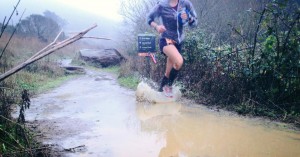
Puddles like this were the norm on the course. (The unidentified runner isn’t me. Photo courtesy of the North Face Endurance Challenge. Click to enlarge the photos in this post.)
I cheered up at the Muir Beach Aid Station—every aid station made me feel better, thanks to the familiar faces and words of encouragement—and I left with a feeling that this isn’t so bad. I generally excel at alternately power-hiking and running the steep 1000-plus-foot ascent up from Muir Beach, and this time was no different. I experienced a surge from Muir back to Tennessee Valley. At the aid station, I yucked it up with some friends. These pictures make it seem like I was enjoying a walk in the park. Actually, I was lingering at the aid station because I was enjoying the company and the break in the running.
I headed up Marincello Road—a steady fire road climb of nearly two miles—telling myself, “I’ve run this before, I can run it again.” Chug, chug, deja vu. I reached the top and struggled to remind myself that this is a race and I should lengthen my stride, which I did with limited success.
Thankfully, I heard a voice query, “Sarah?” I didn’t recognize the face right away, but I knew the voice—Eric Schranz, co-host of Ultrarunnerpodcast.com, the guy who produces the informative and funny daily news digest and interviewed me last September. We traded small talk for a bit. The dose of camaraderie was like a fleece blanket for my chilled spirits and stiff muscles. Our time together was brief, however, because we hit the descent on Rodeo Valley Trail and I told him to go ahead, since my legs weren’t doing well with hammering the downhills.
My mood declined with the slope. I just wasn’t having a very good time—it’s as simple and complex as that. Facing the prospect of repeating the route I had just run seemed increasingly pointless.
A photographer at the bottom of the hill called out, “Can you show me your bib number?” since my shirt partially hid the bib pinned to my shorts—only the “Elite” label at the bottom of it showed, as if to mock me—and I rudely shouted back, “Noooooo! I don’t want any photos!”
At that almost-halfway point, the course hung a left and directed the 50-milers back to the start/finish line at Fort Barry for the aid station. I ran through a mental checklist of what I’d need from my drop bag—change of shirt, more GU, my iPod—to pull myself together and fortify my commitment to stay in the race. Pushing my pace up the paved road leading to Fort Barry, the prospect of listening to music on the second half cheered me up. I had updated my playlist precisely for this occasion.
Suddenly, a wave of scores of fast runners came charging around the corner. Coincidentally, just as I was returning to the start/finish area for the halfway aid station, the marathon race was starting. I felt completely rattled as I scurried to the shoulder of the road and saw the determined faces of so many fresh runners coming my way.
“What the hell?!” I thought, or perhaps said out loud. There I was, supposedly running a 50-mile trail ultra, yet I was on pavement facing an onslaught of marathoners. I was so caught up with thinking, This blows! This is not what I signed up for! that when I reached the aid station and found my drop bag, I didn’t concentrate on swapping out my gear. I wanted to get the hell out of there and back on a real trail before succumbing to the urge to quit. Pissed off, I ran away fast—and got about half a mile down the road before realizing I had forgotten my iPod. So much for the songs that would help in the second half.
I headed back up the hill of the little loop—the same hill we started on at 5 a.m.—and caught back up with Eric. I told him I was thinking of dropping out. “Really?” he asked with genuine surprise. I interpreted that to mean, “You are running fine and don’t appear to have any legitimate reason to drop out,” which was true. I knew objectively that dropping out for no better reason than feeling tired and uninspired would surely lead to regret the following day. I changed the subject to talk about stuff other than running, which made me feel better.
We hit the downhill of Rodeo Valley Trail again. (This was the second time around the “Little Loop” and the third time running this stretch of Rodeo Valley Trail, around Mile 28). Eric pulled ahead again, and my mood plummeted again. The photographer at the bottom of the hill asked for my bib number again. “Noooo!”
If I hung a left, I could go back to the start/finish area at Fort Barry. If I kept straight, I’d go to Tennessee Valley on the Figure 8 part of the route for the final almost-20 miles.
I saw my friend Alita, and she told me to keep going, so I did. Not because I was committed to finishing, but because I didn’t want Alita to witness me dropping out. Secretly, I knew another little pathway back to the start/finish area that I wanted to take rather than going to Tennessee Valley. I was making up my mind to drop out because I realized the timing would work perfectly to get back to the finish area and see the front-runners finish, and wouldn’t it be cool to watch the top men cross the line? I’d chalk up my 29 or so miles to a good training run. My plan made perfect sense.
And then God or serendipity put Adam Ray squarely in my way. If you know me, you might know that my husband and I have been friends with Adam since high school, and he got me into running back in 1994—and, as chronicled in my earlier race report, he kept me from dropping out at Mile 33 at this same event last year. He’s the course marshal for the event, so he was cruising the course to check on things and happened to cross my path at another pivotal moment.
While other runners streamed by, I stopped and stood in the middle of the trail to talk. I told Adam I wanted to drop, and he said the perfect thing in just the right matter-of-fact, unsympathetic tone: “But you just have to run to Muir Beach and back.”
“So how are things going for you? What’s your day been like?” I asked, changing the subject.
He wagged his finger at me with a wry smile. “No, no, no,” he said, “you don’t get to use talking to me as an excuse for not finishing.” Then he turned and walked away, leaving me to do what I knew I had to do if I had any sense of pride or claim to endurance: Run to Muir Beach and back.
I got up and over the hill to Tennessee Valley and headed back up toward Pirates Cove. As the rain eased up and the clouds lifted enough to reveal the coastline, my mood turned more contemplative. I thought about how different—how much better, stronger and more patient—I felt while running the Grand to Grand Ultra two months ago. That multi-day event required us to run back-to-back ultras with a backpack. Yet I was psyched for each day on the trail, in spite of sore legs and flagging energy, because every mile held the promise of discovery. The landscape, the vistas, the challenge, the people—everything about it was new to me.
It hit me that I have a case of burnout, and I need to change things up for the year ahead. Along the curves of Pirates Cove, I came up with a plan that made me quicken my pace: For 2013, I will register for races only if they’re new to me and feel special in some way. I’ll take a year-long hiatus from events in the Marin Headlands, the Oakland Hills and on all the other regional trails that I love but have raced on several times before. I mentally deleted several Bay Area races I planned to sign up for in 2013 and added possible ones in other parts of California, and maybe out of state. All at once, the new year seemed much more ripe with possibilities.
Approaching Muir Beach, I glided and tramped down the greasy-slick mud that bedeviled many runners. These miles were as muddy as a mud-wrestling pit, but for the first time all day I had a bit of fun as I pretended to glissade in snow. I felt twinges of guilt, however, as I saw that our collective footsteps were trashing the trail and widening it by bushwhacking on the sides.
Here are some shots that show the muddy conditions (many thanks to Rick Gaston and Chihping Fu for being out there and sharing their photos):
The Finish
On the return from Muir Beach to Tennessee Valley to the finish, it rained more. I ran slower. Chug, chug, I’ve done this before, I can do it again. Instead of running the whole way up Marincello Road, I gave myself a break with a pattern of walking one minute, running two minutes.
I had fallen so far out of race mode that just finishing was all that mattered … except … looking at my watch I realized I could and should break 9 hours. Oh, what the hell, I might as well.
The last miles were an ugly, scowling act of labor, but I crossed the finish in 8:57. I was completely surprised to see my husband Morgan and dog Teddy there. That was the best reward of all!
There’s no denying the day was a disappointment for me personally. It wasn’t the race I hoped or planned for. But it would have been more disappointing to quit. It took running the final lap on the final Figure 8 to confront the feeling of burnout and gain inspiration to do something about it. I expect that at some point in some future race I’ll draw on this day’s experience to persevere through a rough patch or, conversely, to more fully appreciate and celebrate a victory.
The results showed I was 104 out of 391 participants, 83% or 325 of whom finished the almost-50-mile course. The average finish time was 9:50. The men’s winner, Miguel Heras, won in 5:33, and the women’s winner, Emelie Forsberg, was 28th overall and finished in 6:39. I was 23rd out of 105 women.
Given the circumstances, I’ll take an above-average finish and call it a victory!
For further reading
I enjoyed the race report of Oakland’s Caitlin Smith, since I was rooting for her and she finished 4th, and also, Tim Long’s account of pacing 6th place finisher Tina Lewis. Both of those women struggled mightily and experienced low points that I could relate to, but they kept racing hard and pulled off remarkable performances. I also had fun reading this colorful report from marathoner Pete Ferguson, in which I make a cameo. He captures the exuberance of a newcomer to the sport that I really admire and even envy now.
For a great slide show of the muddy conditions, check out these photos on weather.com!

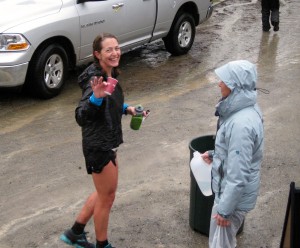
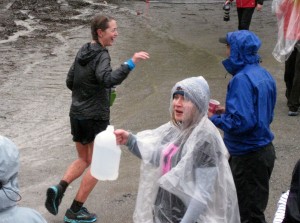
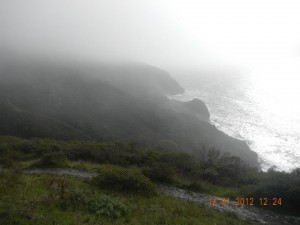
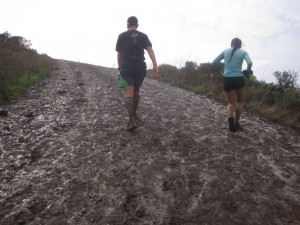
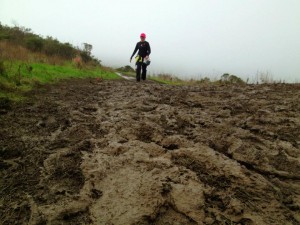
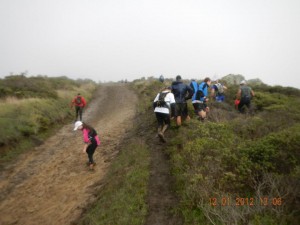
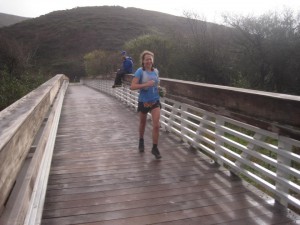
Congrats on finishing! I know it was a rough day out there. 2013 race suggestion(s)… Crow Pass outside of Anchorage, AK and the next weekend Resurrection Pass south of Anchorage. Crow Pass is 23 miles and “Res” is either 50 or 100 miles. I believe they will be held the 3rd and 4th weekends in July. 🙂 A little closer to home is the Waldo 100K in Oregon. Have you run it? Its a beautiful run. Happy Holidays and Happy Training!
As always, a great write up of your experience out on the trails. As one of the marathon runners who appears to have gone by you as you came into the turnaround, I’m glad you found it within you to finish the run.
Hope your 2013 running plans come together nicely. I’ll look forward to reading about them as they occur.
Cheers!
I really enjoyed your race report, and think you did pretty darn good despite your troubles. And I think its pretty cool to have friends out there to root and cheer for you. And you had Morgan out there at the finish! Negative thoughts make you human. Whats important is that you overcame those rough spots and persevered. And I don’t think you’re a poser. I think you legitimately deserve to be up there with the elites. Congrats on the sub-9 finish!
Sarah, If you had dropped at the halfway point I would never have seen you coming up the “Crap Chute”! After seeing you there I had the combo “Wow + Ahhhh I’m gonna die”! look as I snow plow skied down to the turnaround. I had been playing “spot the Rockstars” the whole run so, you completed that portion of my quest! Thanks for your inspiration, writing and fueling my wanderlust for this great running universe I’ve suddenly fallen into in my later years, at a time when I really needed to pick up on something shiny…
That looks like a nasty run! Way to tough it out.
Nice job roughing out a good finish, Sarah.
By the way, regarding having a hard time seeing with your headlamp in the rain, you might want to try holding your headlamp in your hand in those rainy, cloudy conditions. I did, and having the light at a different angle then your eyes makes it a ton easier to see.